Setting your OKRs on a quarterly basis gives you a lot of advantages when it comes to continuous improvement. Teams that use the OKR framework have the opportunity to take what they have learned from one quarter– recording what worked, identifying what didn’t serve them– and use that knowledge to write stronger OKRs and execute their strategy better in the next quarter.
The process of reflecting on your past quarter and putting those learnings into action is an extremely important pillar of any OKR program. In Profit.co, we call this process Reflecting & Resetting.
Reflect & Reset in Profit.co
Profit.co’s Reflect & Reset feature integrates the vital process of applying past learnings to future initiatives directly into your OKR program. With an individually curated series of reflection questions and multiple options for resetting key results and objectives, it is easier to complete one quarter while planning for next quarter’s success.
During the reset process, Profit.co gives you four main actions for your key results:
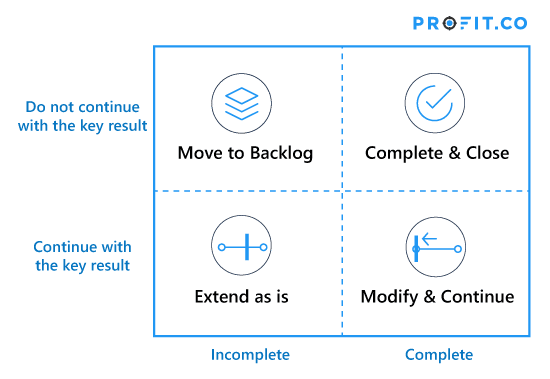
First, if a key result is incomplete and you do not plan to continue with it in the next quarter, you can move it to the backlog. Second, if your key result is complete, and you don’t want to continue tracking this outcome, you can complete and close the key result. Third, if a key result is incomplete but you feel it can contribute to next quarter’s priorities, you can extend the key result as is, giving your team more time to meet their target. And finally, if a key result is complete, but you’d like to continue with it, you can modify your target and continue it in the next quarter.
But the reflect & reset process is about more than answering questions and choosing which key results you’ll choose for your next quarter. This process will not only help you look back on the quarter you just completed, but it will also help you in your next reflect & reset session, and even the one after that, creating a process of learning and improvement that only builds as time goes on.
Reflecting and resetting is vitally important for your future success, both with OKRs and as a business. Giving yourself and your team ample times to complete this end-of-quarter process can help you have better outcomes in future quarters.
4 Steps for Better Reflect & Resets
So, we know that reflecting and resetting is important to your success with OKRs. What can you do to make sure you’re getting the most out of this process?
These are the top four steps that you and your team can use to derive the most information and insight out of this process:
Step 1. Take Inventory of Your “Known Knowns”
The first step toward having a better reflect and reset is to take stock of what you know.
Information exists on a matrix of awareness and understanding. First, there are known knowns– things we are aware of and understand. Then, there are known unknowns– things we are aware of, but don’t understand. Likewise, there are unknown unknowns– things we aren’t aware of, and don’t understand. And finally there are unknown knowns– things we aren’t aware of, but understand.
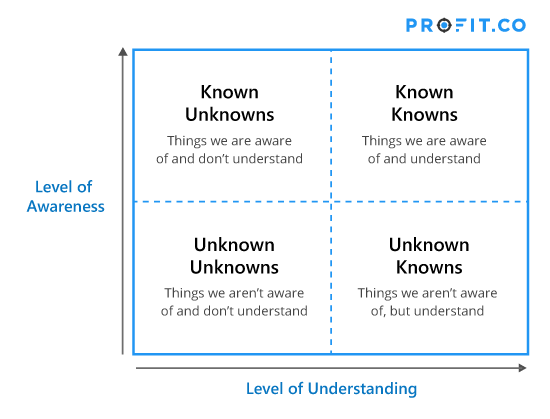
In business, we mostly operate in the known knowns quadrant.
Over the course of a quarter, however, you might have uncovered hidden gems that were previously in the known unknowns, unknown knowns, or even the unknown unknowns category. With new information coming in based on your experiences, those previously unknown things might have migrated to the known knowns category.
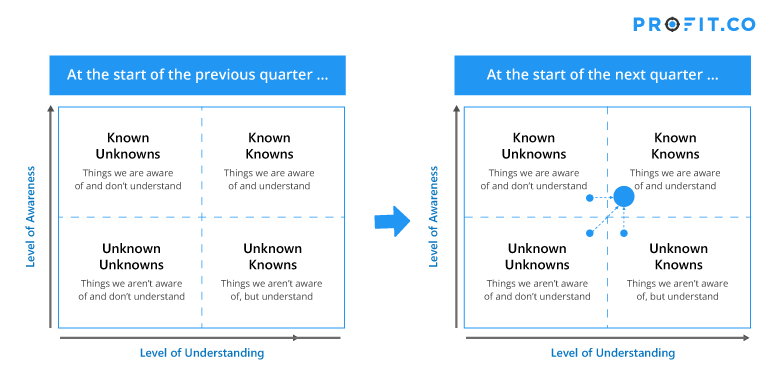
For example, you might have had a hunch that partnerships are key to your success. This hunch falls under the unknown known quadrant. Throughout the course of the quarter, you might get some concrete signals that confirm your hunch. Now, the notion that “partnerships are key to our success” has moved from being an unknown-known to a known known. When you establish an organized process around identifying these hidden gems, it is extremely revealing, enlightening, and clarifying.
Recognizing the information that has fallen under things you are aware of and understand is very important to recognize. You must take inventory of the known knowns quadrant at the end of your quarter and evaluate the information you have at your disposal. During your reflect and reset process, you should determine what this new stock of information means for the decisions you make in the upcoming quarter.
Coming up with new initiatives, shutting the door on initiatives that no longer make sense, and ensuring that your chosen key results are creating the best impact on your organization is the best way to make use of this newfound knowledge and apply the increase of known-knowns.
Step 2. Increase in the level of “Known Knowns”
After you have checked your inventory of known-knowns, it’s time to do some time-travelling.
Think back to the beginning of your previous quarter, and consider it from the perspective you have now with what you have learned over the course of the quarter. Ask yourself some questions about what you expected from the quarter, and how it ended up, such as:
- What did you plan to accomplish?
- What has changed from the beginning of the quarter to the end of the quarter?
- Do the goals you set for yourself and your team make sense now?
- Did your OKRs have the planned impact you were hoping for?
- If not, why?
Once you understand these things and have a grasp of what you planned to happen, you can get a better perspective on your execution of the plan, and the actual impact of the accomplishments you fulfilled in that quarter.
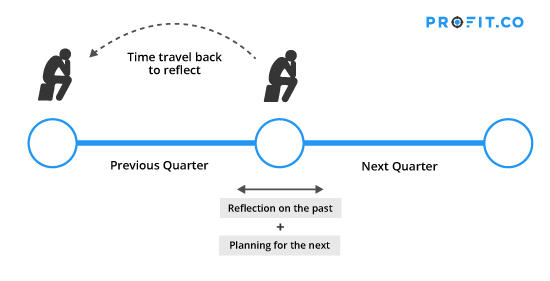
When it comes to work that has not been completed as planned, it is still important to assess the impact during your reflection process. However, you have to answer the critical question: should you continue with that work? Or start something new?
Additionally, there’s an even more important question to ask as you time travel back and forth between your perspective at the beginning of a quarter and the end of it. With these perspectives, you should consider if you could have done something that you didn’t even consider at the beginning of the quarter. Should you have prioritized one initiative over another? What do you wish you had known?
This information is vital to consider as you reset for your upcoming quarter.
For example, let’s say that as you reflect and reset your Q1, you found that you dedicated most of your time to five or six different key results and their corresponding objectives.
However, you remember that, at the beginning of the quarter, you had eight or nine key results that truly felt like top priorities, and you had planned to get done. How did those fall through the cracks? What could you have done to drive progress on those lagging key results? You may have run out of resources, or simply run out of time, but looking from the perspective of both the end of the quarter, and the beginning, you realize that you would have been in a much better position had you focused more on those key results instead of the ones you actually focused on.
Since you were able to remember why these key results were so important from your perspective at the beginning of the quarter, you can reset your OKRs and make these key results your top priority in Q2. In Q2, you can put in renewed focus, energy, and resources behind completing these important key results.
The reflect and reset process can teach you that key results like these can easily fall through the cracks. Designating them as high-priority, and keeping in mind the issues that caused them to lag behind your other targets helps ensure that your team dedicates proper resources to see them completed.
Step 3. Put someone else in your shoes
The next step you can take to ensure you’re getting the most out of your reflect and reset process is putting yourself in someone else’s shoes.
Here, we have a famous example where Andy Grove, the father of OKRs and former CEO & Chairman of Intel, posed a question that would help business leaders for years to come think outside of the box and outside of their own perspective:
In the midst of the doldrums of 1985, Grove posed a hypothetical question to his colleague Gordon Moore: “If we got kicked out and the board brought in a new CEO, what do you think he would do?” Moore answered without hesitation, “He would get us out of memories.” To which Grove responded, “Why shouldn’t you and I walk out the door, come back and do it ourselves?” – Harvard Business Review, 1996
Taking a moment to consider your progress, problems, and plans from a new perspective can change your business for the better. This doesn’t have to be between two C-level executives, however– this can be framed as a group exercise.
How might this exercise look in an example situation?
Let’s say you are the head of the marketing department and call a meeting with your direct reports. If you were to tell them to imagine that the CEO decided to replace you, and all your directs, because he feels you need new energy on the team, what would this new team do first?
Have an open conversation with your team. Ask follow-up questions such as:
- What would be on top of that new team’s list of priorities?
- What things would they immediately stop doing?
- What practices would be kept, and what would be discarded for something more efficient?
Trying to identify issues from this perspective can ensure that your team is focusing on the most important things.
This exercise can also be done alone. What would someone new do in your exact position, with the exact issues and resources you have today?
The key to finding valuable insight with this exercise is being open, honest, and making your team comfortable with facing the reality of their situation. Create an environment where people feel safe to identify the real issues, and ensure that people feel the value in this exercise.
While some people might feel that this is a waste of valuable work time, setting the right tone and creating a relaxed atmosphere can encourage people to voice their opinion openly and suggest ideas that they might not feel comfortable voicing in the context of regular work. Carving out space for people to take on a new perspective, and letting yourself critically and objectively examine that state of your initiatives is a great way to ensure you are getting the most out of your reflect and reset process.
Step 4. Time travel into the future to the end of the new quarter
Finally, once you have your initiatives planned out for the next quarter, it’s time to break out the time machine once again. This time, time travel to the end of your next quarter, and try to envision what that might look like after you have accomplished everything you have planned and gained new knowledge.
At the 90-day mark, if you have accomplished the five or ten priorities you’ve identified for the quarter, will you be happy with your progress? If all goes according to plan, will you be satisfied and be able to say that you have no regrets about what you have dedicated time to, or doubt about the importance of prioritizing these initiatives over others? Can you picture yourself saying “I am happy with my achievements” at next quarter’s reflect and reset?
Ask yourself some questions about your state of mind, and the state of your business, if everything goes according to plan:
- Am I happy with the things I have accomplished?
- Do I have any regret over choosing these things as my priorities?
- Do I wish I could have focused on different initiatives?
- If so, what are they?
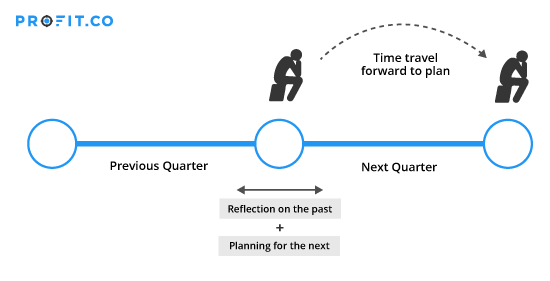
This exercise acts as a verification process that helps confirm if your plan is the right one. Once creating your strategy for the quarter, it’s not wise to simply walk away and see how it works out in 90 days. Instead, you need to think about what you will feel if you execute this strategy perfectly. If there is any trace of doubt or regret, you need to reevaluate and verify your plan with this exercise once again until you know with complete confidence that you will be happy with your achievements.
Weekly or biweekly check-ins grant you the opportunity to ensure that your strategy is going according to plan, however answering these questions can help you perform a higher-level confirmation. This determines if you are committing time, energy, and resources to the right key results, and gives you the opportunity to change course before you begin.
Final Thoughts
The reflect and reset process at the end of your OKR quarter is the most important thing that you can do to help your business build a stronger and more effective OKR program. Finding ways to derive more value from this process and gather as much insight as possible puts you on the fast track to reaching your goals and honing a more focused and energized team.
The reflect and reset feature in Profit.co builds this vital part of the OKR framework into your quarterly rhythm, and coaches you to ask the right questions and thoroughly considers your options as you move from one quarter to the next.
For more information on how Profit.co helps you manage your OKR program, visit our product page, book a free demo, or try Profit completely free for 30 days!
